HOW CHAMPIONS DO IT
Researched, produced, and prepared by Brent S. Rushall,
Ph.D., R.Psy.

COACHING ERROR REVISITED -- MICHAEL KLIM'S CRAWL STROKE
Michael Klim once was one of the world's premier crawl-stroke swimmers. In a semi-final at the Sydney Olympic Games, he briefly held the world record for 100m freestyle having recorded a time of 48.18 seconds. As was analyzed and explained in a previous issue of How Champions Do It, he has been coached to perform a butterfly kick with his crawl stroke arm action (click here to visit that issue LINK). In the final of 100-m freestyle at the Sydney Games, he used this hybrid stroke starting about 5 meters from the finish. It slowed him considerably, and he finished out of the medals. Hybrid stroking of this form is biomechanically unsound.
At the 2001 Australian World Championships Trials held in Hobart, Tasmania, Michael Klim failed to qualify for any individual freestyle event for the World Championships. What was remarkable was that he performed more hybrid stroke swimming during the 100 m than at the Olympics!
In this analysis, Michael Klim's performance in the 100-m freestyle final is analyzed. Two parts of the race are compared. His orthodox stroke at 70 m into the race is demonstrated on the right in all displays. On the left is the hybrid stroke that was performed at 78 m into the race. Michael Klim was leading at 70 m. By the time the roughly 10 m of hybrid swimming was completed, he was a distinct third behind Ian Thorpe and Ashley Callus. A very clear demonstration of how the hybrid stroke is slower than the orthodox crawl stroke was provided.
This analysis compares the kinematic factors involved in the hybrid (butterfly-kick) stroke and the orthodox crawl stroke. Each frame is .1 seconds apart.
This stroke analysis includes moving sequences in real time where each frame is displayed for .5 of a second, and still frames.
The following image sequences are in real time. It will play through 10 times and then stop. To repeat the sequence, click the browser's "refresh" or "reload" button. The left image is the hybrid stroke and the right image the orthodox stroke.
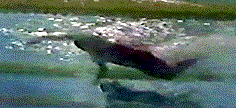
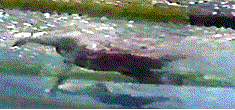
The following image sequence shows each frame for half a second. It will play through 10 times and then stop. To repeat the sequence, click the browser's "refresh" or "reload" button. The left image is the hybrid stroke and the right image the orthodox stroke.
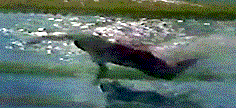

At the end of the following narrative, each frame is illustrated in detail in a sequential collage.
Notable Features
Frames B1 and C1: In the hybrid stroke (B1), as the left arm enters, the right arm is well under the body with the elbow leading (a slightly dropped-elbow position). In contrast, C1 shows the right arm still in front of the shoulder. The body streamline in B1 is angled down, while in C1 it is flat. The extra resistance produced in B1 can be seen by the greater volume of "milky" water (drag force turbulence) behind the swimmer when compared to C1.
Frames B2 and C2: B2 shows the pulling right arm beginning its exit, while in C2 it is mid-pull. The increase in frontal cross-sectional area produced by the thighs is also evident in B2, but in C2 streamline is maintained. The butterfly kick at this stage is producing vertical forces only. The left arm in C2 is held forward, waiting until it is best to commence its pull. It would serve no purpose to overlap with the right arm pull.
Frames B3 and C3: B3 demonstrates the commencement of the left arm pull. The right arm action is completed. The powerful vertical butterfly kick of the legs has forced the swimmer's hips upward. In this position, the tops of the buttocks are level with the top of the head. The angle of the legs increases resistance. In C3, the right arm is still propelling.
Frames B4 and C4: In B4, the left arm is propelling, the legs and body are streamlined, but the feet are "dragging." The propulsion position is not optimal. Adduction has started and the forearm/hand propelling surface is angled, rather than being vertical. The arm is also low. C4 shows the left arm still extended forward as the right arm exits. Streamline is still good in C4.
Frames B5 and C5: The B5 pull is underway but streamline is totally disrupted. Hyperextension of the lumbar region has dramatically increased the cross-sectional area of the swimmer and thus, increased resistive drag. The left arm begins to be repositioned in C5. The elbow stays high and elbow flexion and upper arm medial rotation begin. Streamline is maintained.
Frames B6 and C6: B6 illustrates complete disruption to streamline, as a preparatory movement to kicking. The right arm has entered while the left arm begins to extend as adduction is completed. In contrast, C6 illustrates a classic elbow-up pull. Adduction is powering a vertical hand/forearm propelling surface and streamline is excellent.
This first series of frames suggests that the butterfly kicking action does the following.
- Shortens the effective propulsive pull of the arms.
- Increases stroke rate (due to the shorter pulling cycle) although velocity is decreased.
- Disrupts streamlining.
- Increases frontal drag resistance and wave resistance.
- Produces unnecessary vertical forces.
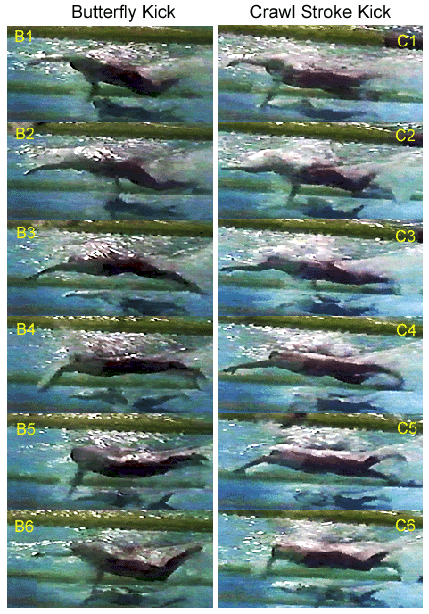
Notable Features (continued)
Frames B7 through B11 exhibit the following features about the hybrid stroke pattern.
- The effect of the downward kick (frame B7 and B8) is not as dramatic as earlier.
- The elbow in the right arm pull collapses halfway through the pull (frame B10). This probably occurs as the effective pull is shortened. The tragedy of this feature is that it occurs when the stroke should be most effective. This position should be compared with the orthodox position in frame C12.
- The disruption to streamlining still occurs, but not as much as occurred during the left arm pulling action.
Frames C7 through C13 exhibit the following features about the orthodox stroke pattern.
- Good streamlining is maintained through the total stroke.
- A high-elbow position is established by the right arm early in the stroke and in front of the swimmer (frame C11).
- Propulsion comes primarily from the hand/forearm surfaces (C11-C13).
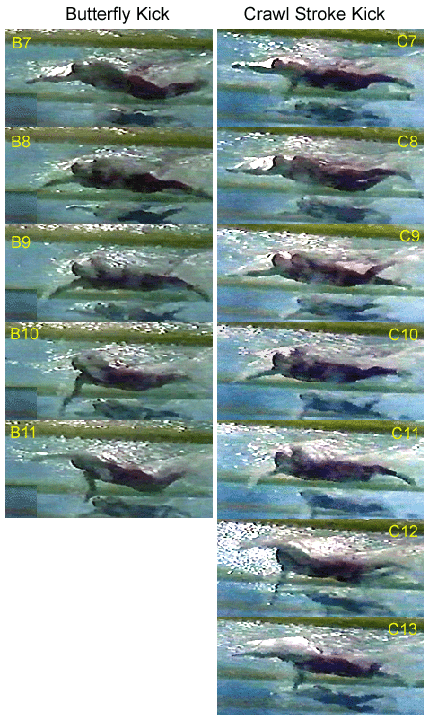
General Conclusions
The introduction of a butterfly kick into a crawl stroke movement pattern decreases swimming velocity. There are several detrimental effects when the hybrid stroke is swum.
- The effective pull of the arms is shortened, mainly by "chopping-off" the latter part of the potential arm stroke. That reduction usually occurs by collapsing the elbow early in the pull.
- Stroke rate increases while swimming velocity decreases. The timing of the stroke changes to that exhibited in the orthodox stroke.
- The vertical undulating movements of the hips that occur as reactions to downward butterfly kicks, dramatically increases wave resistance making the stroke more tiring and energy consuming.
- Streamlining is disrupted in the hybrid stroke, the increased resistance to progression through the water possibly contributing the most to the diminution in swimming velocity. To facilitate performing the butterfly kick, the torso and thighs are angled downward for an instant, attaining a position that should be avoided in any stroke.
- At no time in any of the hybrid kicks in these sequences are the forces developed mainly backward (as in butterfly swimming). The forces created are not equivalent to those produced in full butterfly swimming. The assumption that they would be is false.
- Performing a butterfly kick de-emphasizes the arm pull as the added effort to execute it dominates the swimmer's movement pattern. When a movement is dominant, but non-propulsive, it is a wrong movement and one that needs to eliminated and avoided.
- Performing a butterfly kick with a crawl stroke arm action is STUPID.
Return to Table of Contents for this section.









